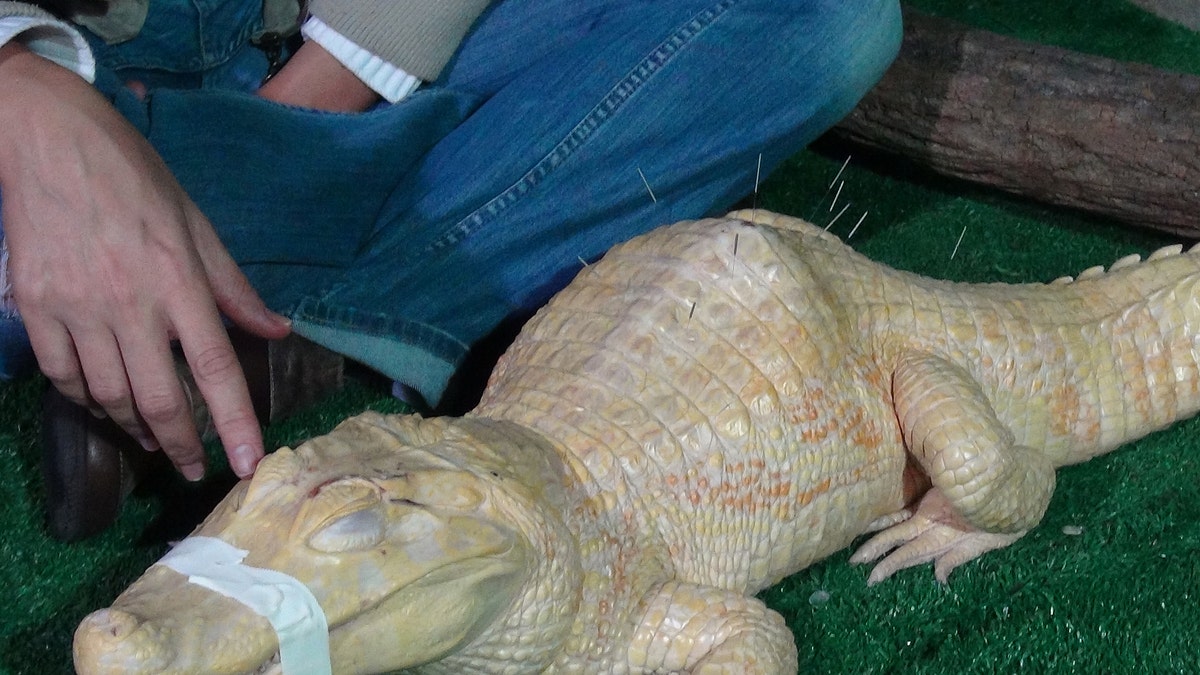
Bino, the albino alligator, receives acupuncture treatment in Sao Paulo, Brazil, Tuesday, Aug 27, 2013. (AP2013)
What's an albino alligator suffering from scoliosis to do? Acupuncture, naturally.
Bino, the albino alligator, spends his days at the Sao Paulo Aquarium in Brazil, where he's been living since 2007. He was born eight years ago unable to move two of his legs and, according to veterinarians, he suffers from excruciating back pain.
Nothing seemed to alleviate Bino, so in early 2011 veterinarians decided to see if acupuncture might help, as it has helped other animals living at the aquarium.
"The acupuncture will ... alleviate his pain and keep all his vital functions going," said Rafael Gutierrez, a biologist at the aquarium of Sao Paulo, adding that the 30-minute weekly treatments would continue indefinitely, as long as it kept showing solid results.
Acupuncture on animals is becoming increasingly common around the globe, the biologists at the Sao Paulo aquarium said, especially with pets such as cats, dogs and horses. The use of acupuncture on animals began thousands of years ago in China.
- Saving Monkey Will Save our Forest, Brazil Says
- Brazil Sends Beached Penguins to California for Their Health
- Brazil’s Carnival is Going to the Dogs
- Argentine Zoo Shows Its New Tiger Cubs
- Exotic Narco Pets Hit Zoos After Cartel Kingpin Owners Hit The Slammer
- Jaguar and Lion Cubs Add to Mexican Zoo’s Record with Big Cats
- 350-Pound Blue Marlin Jumps Aboard Fishing Boat
- Zurich Launches Drive-In ‘Sex Box’ Experiment To Make Prostitution Safer For Women
- Woman Risks Life To Lose Weight By Swallowing Tapeworm
- World’s Largest Baby Born In Mexico Weighing 14 Pounds, 8 Ounces
In the U.S., the number of veterinarians who hold membership in the American Academy of Veterinary Acupuncture has jumped 50 percent in the last few years to 900 doctors, said Simon Flynn, the executive director of the academy that's based in Glastonbury, Connecticut.
"There are many zoo veterinarians who use acupuncture, a number of equine practitioners who treat race horses with acupuncture, it's proven to be a useful treatment," Flynn said. "It's common with dogs and it's becoming increasingly common with cats. More veterinarians are seeing the worth of the treatment."
Typical ailments treated by acupuncture include neck and back issues, skin problems and pain in general, among other complaints, said Flynn.
Bino the Sao Paulo alligator requires a few precautions not needed with your average house cat. Inserting the needles into Bino's back requires the important first step of taping shut his lock-tight jaws full of sharp teeth.
Bino wrestles around a bit as the tape is applied, but soon calms down.
Veterinarian Daniela Cervaletti then slides behind Bino, firmly pressing the needles into his leathery white and yellow hide. The needles are inserted along his spine and around the area where the animal developed a hunchback.
Bino doesn't move at all as nearly a dozen needles go in.
Cervaletti gently strokes the side of Bino's neck after she applies them all, then waits several minutes before removing them.
The treatment complete, handlers help Bino back into a display pool, his white skin stark against brown fake rocks painted with foliage.
He moves easily and swishes his tail, gliding along the water as a gaggle of young schoolchildren in matching blue and gray uniforms squeal in delight, faces pressed up against the glass separating them from Bino.
Based on reporting by The Associated Press.
Follow us on twitter.com/foxnewslatino
Like us at facebook.com/foxnewslatino
